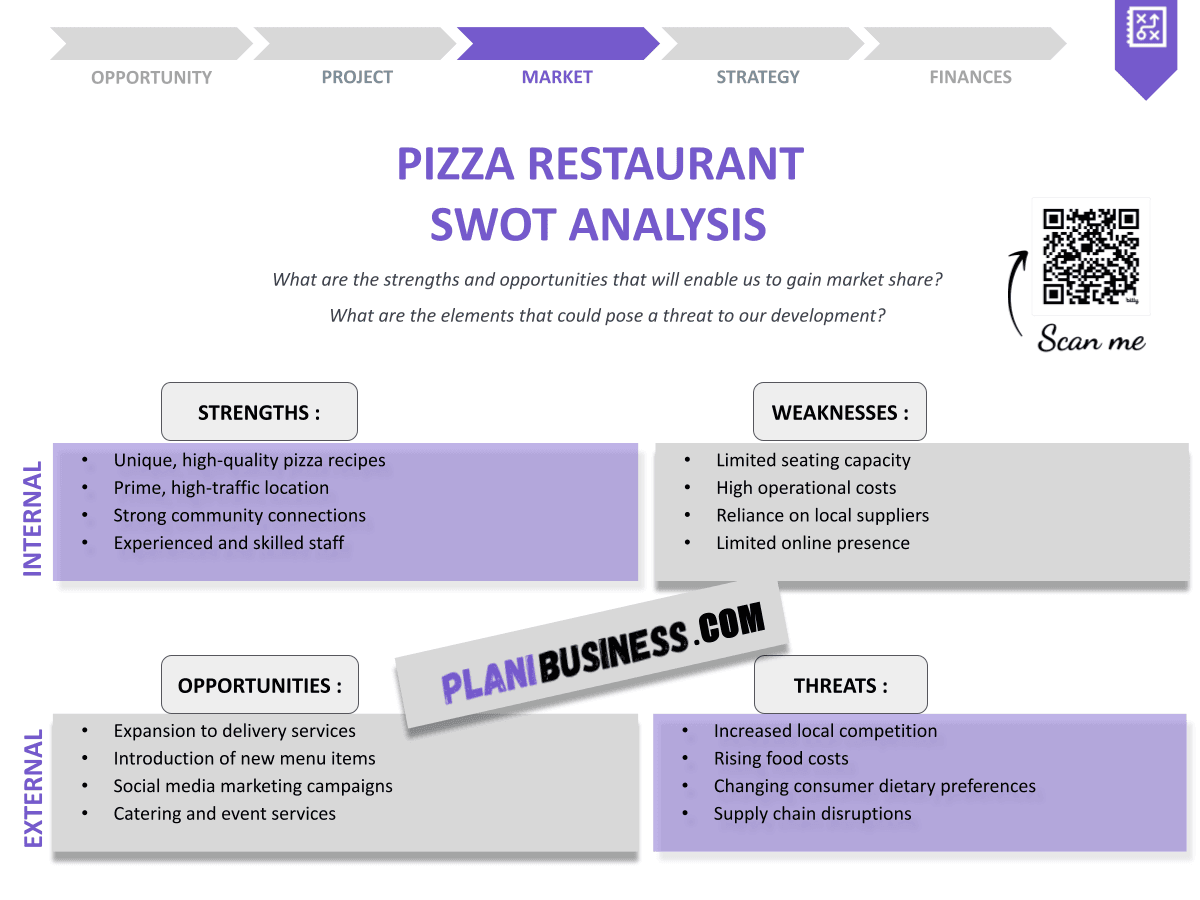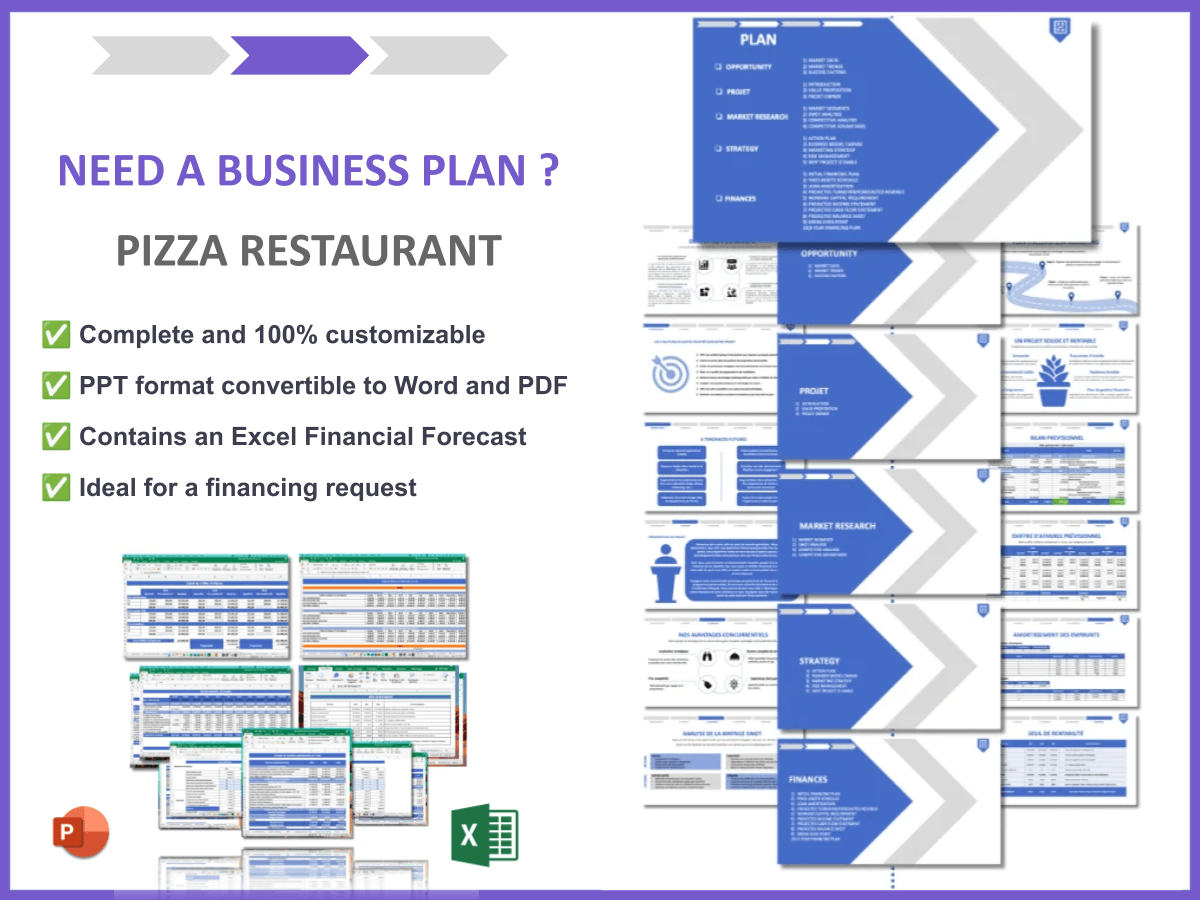Why Should You Have a SWOT Analysis for Your Pizza Restaurant?
Are you thinking about starting a pizza restaurant? You’re not alone! According to market research, the global pizza market was valued at over $130 billion in 2020, and it’s only getting bigger. A SWOT analysis for your pizza restaurant is crucial because it provides a clear picture of your business’s internal strengths and weaknesses, along with external opportunities and threats you’ll face in today’s competitive landscape. It makes a difference you make educated choices that can lead to success.
Definition: A SWOT analysis is a strategic planning tool used to identify an organization’s strengths, weaknesses, opportunities, and threats.
- Maximizes strengths
- Minimizes weaknesses
- Capitalizes on opportunities
- Aids in mitigating threats
- Provides structured planning
- Fosters competition awareness
- Enhances strategic direction
- Encourages team collaboration
- Increases overall resilience
- Supports long-term success
How Do You Write a SWOT Analysis for a Pizza Restaurant?
Writing a SWOT analysis can seem overwhelming at first, but breaking it down makes it manageable. Start by gathering input from your team and any other stakeholders. Here’s how you can do it:
Strengths
Your pizza restaurant may have unique recipes, a loyal customer base, or an ideal location. Consider what makes your restaurant stand out.
Weaknesses
Maybe your pricing is higher than competitors, or you struggle with marketing. Identifying weaknesses lets you address them head-on.
Opportunities
Opportunities could include new food trends, partnerships, or community events. Keep an eye out for unique ways to grow.
Threats
Threats might involve things like new competitors or changes in food regulations. It’s crucial to stay updated on potential challenges.
SWOT Example N°1 for “Pizza by the Slice”
A popular, quick-service pizza spot focusing on slices rather than whole pies can illustrate a great case study. This type of restaurant capitalizes on the fast-paced lifestyle of modern consumers.
| SWOT | Analysis |
|---|---|
| Strengths | Fast service, unique flavor options |
| Weaknesses | Limited seating |
| Opportunities | Growing food delivery market |
| Threats | New competitors nearby |
- Appeals to on-the-go customers.
- Unique offerings can attract social media attention.
- Risk of new competitors entering the slice market.
- Must continuously update marketing strategies.
“Staying relevant in taste keeps the return customers coming back.”
SWOT Example N°2 for “Family Meal Pizzas”
A family-style pizzeria aiming to create a warm atmosphere demonstrates another effective approach. This type of restaurant targets families looking for dining experiences.
| SWOT | Analysis |
|---|---|
| Strengths | Family-friendly environment |
| Weaknesses | Higher price point |
| Opportunities | Local events for promotion |
| Threats | Rising ingredient costs |
- Family-oriented theme can create repeat customers.
- Consideration of price points for different demographics.
- Collaborations with local events enhance visibility.
- Cost management essential for sustainability.
“Creating memorable family experiences strengthens customer loyalty.”
SWOT Example N°3 for “Gourmet Neapolitan Pizzeria”
A high-end pizzeria specializing in gourmet pizza offers another fascinating example. This restaurant emphasizes quality and authentic preparation methods.
| SWOT | Analysis |
|---|---|
| Strengths | Premium ingredients and unique recipes |
| Weaknesses | Limited parking |
| Opportunities | Celebrity chef collaborations |
| Threats | Economic downturn affecting sales |
- High-quality ingredients can attract food enthusiasts.
- Parking limitations can deter potential customers.
- Collaborations can elevate brand status.
- Awareness of economic trends necessary to maintain profitability.
“Quality speaks, and that’s what sets us apart from the rest.”
SWOT Example N°4 for “Vegan Pizza Restaurant”
A restaurant dedicated to making delicious vegan pizzas serves as an excellent case study. This establishment meets the growing demand for plant-based options.
| SWOT | Analysis |
|---|---|
| Strengths | Specialty in vegan alternatives |
| Weaknesses | Smaller target market |
| Opportunities | Rising demand for plant-based pizza |
| Threats | Misconceptions about vegan food |
- Specialization can create a niche market.
- Market better to the growing health-conscious demographic.
- Clear away myths associated with vegan offerings.
- Adaptability is key during trends.
“Changing perceptions about vegan food is a gradual but rewarding process.”
SWOT Example N°5 for “Mobile Pizza Truck”
A mobile food truck serving pizza at events and festivals exemplifies a flexible approach in the restaurant industry. This model caters to a diverse customer base while being adaptable to various locations.
| SWOT | Analysis |
|---|---|
| Strengths | Flexibility in location |
| Weaknesses | Weather dependency |
| Opportunities | Expanding into corporate catering |
| Threats | Local restrictions for food trucks |
- Can cater to various events, increasing sales opportunities.
- Must monitor weather conditions for operation.
- Diversifying services can enhance revenue.
- Staying compliant with regulations is a must.
“Flexibility is both a gift and a challenge in the food truck business.”
SWOT Example N°6 for “Traditional Italian Pizzeria”
A restaurant focused on authentic Italian recipes provides another effective example. This type of establishment draws customers seeking traditional flavors and experiences.
| SWOT | Analysis |
|---|---|
| Strengths | Authentic recipes and heritage |
| Weaknesses | High competition |
| Opportunities | Increased interest in cultural foods |
| Threats | Fast casual dining chains |
- Tradition can create powerful customer loyalty.
- Need to differentiate from ever-growing competition.
- Cultural events can promote menu.
- Watch out for new dining trends.
“Authenticity in pizza is our main selling point.”
SWOT Example N°7 for “Small-town Pizzeria”
A local favorite famous for its homey vibe showcases another successful model. This pizzeria thrives on community support and a loyal customer base.
| SWOT | Analysis |
|---|---|
| Strengths | Community ties |
| Weaknesses | Limited marketing budget |
| Opportunities | Local partnerships and sponsorships |
| Threats | Larger chains entering the market |
- Being involved in the community drives word-of-mouth marketing.
- Collaborations can enhance brand identity.
- Limited funds for marketing require creativity.
- Staying vocal about local freshness to combat larger chains.
“Community support keeps our doors open.”
SWOT Example N°8 for “Foodie Pizza Joint”
A trendy spot catering to food enthusiasts illustrates the importance of market positioning. This joint attracts a niche audience with a focus on unique offerings.
| SWOT | Analysis |
|---|---|
| Strengths | A strong social media presence |
| Weaknesses | High customer expectations |
| Opportunities | Collaborations with local producers |
| Threats | Online reviews can harm reputation |
- Social media presence attracts a niche audience.
- High standards can lead to pressure on staff.
- Partnering with local businesses can foster goodwill.
- Managing online reputation is crucial for customer trust.
“In today’s age, reviews are just as vital as the food we serve.”
SWOT Example N°9 for “Delivery-Only Pizza Service”
A pizzeria that strictly focuses on delivery exemplifies a growing trend in the food industry. This model allows for lower overhead costs while catering to the needs of modern consumers.
| SWOT | Analysis |
|---|---|
| Strengths | Lower overhead costs |
| Weaknesses | No dine-in atmosphere |
| Opportunities | Growing trend in food delivery |
| Threats | High competition from delivery apps |
- Can pass savings onto customers.
- Customer retention relies solely on food quality.
- Using promotions can draw new customers.
- Keep an eye on competitors’ delivery options.
“Delivering quality food straight to your door is our mission.”
SWOT Example N°10 for “Artisanal Pizza Parlor”
A place known for unique combinations and artisan ingredients showcases creativity in the pizza industry. This pizzeria thrives by offering innovative dishes that attract adventurous eaters.
| SWOT | Analysis |
|---|---|
| Strengths | Unique flavor profiles |
| Weaknesses | Higher ingredient costs |
| Opportunities | Trend towards gourmet food |
| Threats | Price-sensitive consumers |
- Unique offerings can attract adventurous eaters.
- Costs need careful monitoring to stay profitable.
- Focusing on the health trend can yield rewards.
- Pricing strategy is crucial for competitiveness.
“Innovation in flavor is what keeps customers intrigued.”
Conclusion
In conclusion, a SWOT analysis for your pizza restaurant isn’t just a good idea—it’s essential. Understanding where you stand in each category can lead to smarter decisions about your operation. The right insights can elevate your pizza business to new heights. If you’re serious about starting a restaurant, consider utilizing a professional guide. Check out this business plan template for pizza restaurants that will help streamline your process. Additionally, for more insights, read our articles on How To Start a Pizza Restaurant? and How To Write a Pizza Restaurant Marketing Plan?.
Frequently Asked Questions (FAQ)
What is a pizza business plan?
A pizza business plan is a formal document that outlines the strategy and operational details of your pizza restaurant.
How can I conduct effective market research for my pizza restaurant?
You can conduct effective market research by analyzing competitors, surveying customers, and studying industry trends.
What are some common marketing strategies for pizza restaurants?
Common marketing strategies include social media campaigns, local advertising, and partnerships with delivery apps.
What factors contribute to operational efficiency in a pizza restaurant?
Operational efficiency can be enhanced through optimized kitchen layouts, effective staff training, and good inventory management.
How important is customer feedback?
Customer feedback is crucial as it helps you improve your menu and service based on real experiences.
What role does brand positioning play?
Brand positioning defines how your restaurant stands out in a crowded market, attracting the right customer base.
Why is tracking industry trends beneficial?
Tracking industry trends allows you to adapt and innovate, keeping your restaurant relevant and appealing to customers.
How do I develop a successful marketing plan for my pizza restaurant?
Start by identifying your target market, setting clear goals, then outline tactics to reach and engage your audience effectively.
What should I include in a financial forecast for my restaurant?
Your financial forecast should include anticipated revenues, expenses, and expected profitability over a specific timeframe.
How do I ensure quality ingredients for my pizza?
Build relationships with local suppliers and prioritize sourcing quality ingredients to elevate your menu offerings.







